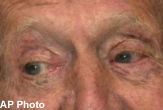
Scientists have found a malformed protein whose unhealthy buildup inside cells can lead to fatal paralysis and dementia in sufferers, a new study finds.
High concentrations of a protein called TDP-43 was found in the brains and spinal cords of people who suffered from amyotrophic lateral sclerosis (ALS), also known as Lou Gehrig's disease, and frontotemporal dementia (FTD).
ALS is a fatal disease that slowly paralyzes the body by wasting away motor neurons that control muscles. FTD is an umbrella term that covers a wide range of behavioral disorders like sex addiction and shoplifting. FTD is often accompanied by a loss of memory, motor skills and speech. FTD is the second most common cause of dementia in people under the age of 65. The leading cause is Alzheimer's, another neurological disease also characterized by abnormal buildup of proteins inside cells.
Scientists have long suspected a link between ALS and FTD because sufferers of one disease often develop symptoms of the other. The new finding explains the overlap by showing the two diseases share the same root cause.
The new study found that whether a person develops ALS or FTD depends on whether TDP-43 accumulates [image] in spinal cord or brain neurons, respectively. Under normal circumstances, TDP-43 is thought to be involved in the upkeep of DNA.
The study, led by Virginia Lee and John Trojanowski of the University of Pennsylvania, is detailed in the Oct. 6 issue of the journal Science.
- Researchers Create Dementia 'Risk Score'
- Mental Exercise Nearly Halves Risk of Dementia
- Alzheimer's Find: Molecular Janitors Quit Cleaning Up
- Red Wine May Help Prevent Alzheimer's
Sign up for the Live Science daily newsletter now
Get the world’s most fascinating discoveries delivered straight to your inbox.
Most Popular

